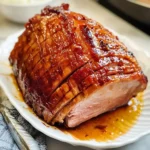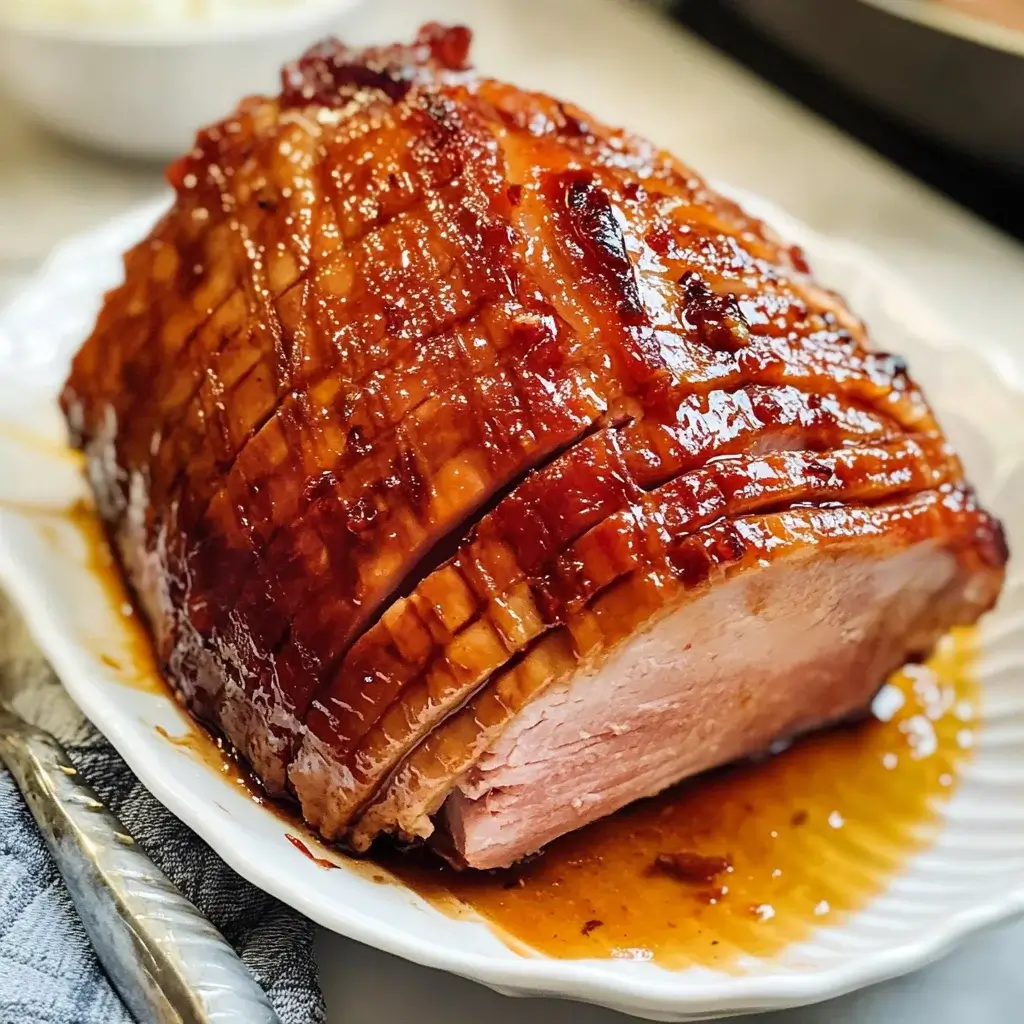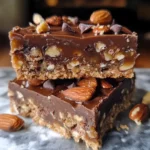Every holiday season, our family gatherings are a joyous occasion filled with laughter, warmth, and of course, delicious food. While we cherish all the dishes on the table, there’s one centerpiece that consistently draws gasps of admiration and eager anticipation: the Glazed Apricot Ham. This isn’t just any ham recipe; it’s a symphony of flavors where the savory richness of perfectly cooked ham meets the bright, fruity sweetness of apricot. The glaze, oh, the glaze! It’s a sticky, glistening masterpiece that caramelizes beautifully in the oven, creating a tantalizing aroma that fills the entire house. From the moment I first tried this recipe years ago, it became an instant family favorite. Even my pickiest eaters, who usually shy away from fruit with meat, find themselves coming back for seconds (and thirds!). The combination is simply irresistible, a perfect balance of sweet and savory that elevates a simple ham into a gourmet delight. This Glazed Apricot Ham recipe is not just about a meal; it’s about creating memories, sharing joy, and enjoying a culinary experience that’s both impressive and surprisingly easy to make. Trust me, once you try this recipe, it will become your go-to ham for every special occasion, leaving your guests raving and your family begging for more.
Ingredients for Glazed Apricot Ham
- Bone-in Ham or Boneless Ham (8-10 pounds): The star of the show! Choose a fully cooked ham, either bone-in for a richer flavor and traditional presentation, or boneless for easier slicing. Spiral-cut hams work beautifully as the glaze penetrates the slices effectively.
- Apricot Preserves (1 ½ cups): The key to the sweet and fruity glaze. Opt for a good quality apricot preserve, as it will be the primary flavor component of the glaze.
- Dijon Mustard (¼ cup): Adds a tangy depth and complexity to the glaze, balancing the sweetness of the apricot and enhancing the savory ham flavor.
- Brown Sugar (¼ cup, packed): Provides sweetness and helps create a rich, caramelized glaze. Light or dark brown sugar works well, with dark brown sugar offering a slightly molasses-like note.
- Apple Cider Vinegar (2 tablespoons): Adds a touch of acidity to cut through the sweetness and create a more balanced flavor profile in the glaze. It also helps tenderize the ham slightly.
- Soy Sauce (1 tablespoon): Introduces a savory umami element to the glaze, enhancing the overall depth of flavor and complementing the ham beautifully. Low-sodium soy sauce is recommended to control saltiness.
- Ground Ginger (1 teaspoon): Adds a warm, subtle spice note that complements both the apricot and ham flavors, creating a more complex and aromatic glaze.
- Garlic Powder (1 teaspoon): Enhances the savory notes of the glaze and adds a subtle savory depth that works wonderfully with the ham.
- Water or Pineapple Juice (¼ cup): Used to thin the glaze slightly, making it easier to brush onto the ham and ensuring it coats evenly. Pineapple juice adds an extra layer of fruity sweetness that complements the apricot.
- Fresh Rosemary Sprigs (optional, for garnish): Adds a beautiful aromatic touch and visual appeal to the finished ham.
Instructions for Glazed Apricot Ham
- Preheat Your Oven and Prepare the Ham: Begin by preheating your oven to 325°F (160°C). While the oven is heating, prepare your ham. Remove the ham from its packaging and place it in a large roasting pan. If you are using a bone-in ham, place it cut-side down. If using a boneless ham, place it flat side down. If your ham has a skin, you can score it lightly in a diamond pattern using a sharp knife, being careful not to cut too deeply into the meat. Scoring helps the glaze penetrate the ham and creates a visually appealing presentation.
- Prepare the Apricot Glaze: In a medium saucepan, combine the apricot preserves, Dijon mustard, brown sugar, apple cider vinegar, soy sauce, ground ginger, garlic powder, and water or pineapple juice. Place the saucepan over medium heat and stir continuously until the preserves and brown sugar are fully melted and the glaze is smooth and well combined. Bring the glaze to a gentle simmer, then reduce the heat to low and let it simmer for about 5-7 minutes, stirring occasionally, until it thickens slightly. Simmering helps the flavors meld together and creates a richer, more concentrated glaze. Remove the glaze from the heat and set aside.
- Bake the Ham Initially: Pour about ½ cup of water or pineapple juice into the bottom of the roasting pan. This creates steam which helps keep the ham moist during the initial baking process. Cover the roasting pan tightly with aluminum foil. This step is crucial to prevent the ham from drying out while it heats through. Bake the ham in the preheated oven for approximately 10-12 minutes per pound, or according to the package directions for your specific ham. The goal at this stage is to heat the ham thoroughly, as it is already cooked. Use a meat thermometer to ensure the internal temperature of the ham reaches 140°F (60°C).
- Glaze the Ham: Once the ham has reached an internal temperature of 140°F (60°C), remove it from the oven and carefully remove the aluminum foil. Increase the oven temperature to 375°F (190°C). Generously brush about half of the apricot glaze evenly over the entire surface of the ham, making sure to get into any scores or crevices. If using a spiral-cut ham, ensure the glaze gets between the slices.
- Glaze and Bake Again: Return the ham to the oven, uncovered, and bake for another 15-20 minutes, or until the glaze is beautifully caramelized and slightly sticky. Baste the ham with the remaining glaze every 5-7 minutes during this final baking period. Basting helps build up layers of flavor and ensures a glossy, evenly glazed finish. Keep a close eye on the ham during this stage to prevent the glaze from burning. If the glaze starts to darken too quickly, you can loosely tent the ham with foil.
- Rest the Ham: Once the glaze is caramelized and the ham is heated through, remove it from the oven and let it rest for at least 10-15 minutes before carving. Resting allows the juices to redistribute throughout the ham, resulting in a more tender and flavorful final product. While the ham is resting, the internal temperature will continue to rise slightly.
- Carve and Serve: After resting, carve the Glazed Apricot Ham and arrange it on a serving platter. Garnish with fresh rosemary sprigs, if desired, for a touch of freshness and visual appeal. Serve immediately and enjoy the delightful combination of sweet and savory flavors!
Nutrition Facts for Glazed Apricot Ham
(Per Serving, approximate values, based on 10 servings from an 8-pound ham. Nutritional values can vary based on specific ingredients and ham type.)
- Serving Size: 4-6 ounces (113-170 grams) of ham
- Calories: Approximately 350-450 kcal
- Protein: 30-40 grams
(Note: These are estimated values. For precise nutritional information, use a nutrition calculator with the specific brands and types of ingredients used.)
Preparation Time for Glazed Apricot Ham
- Prep Time: 20-25 minutes (Includes glaze preparation and ham prep)
- Cook Time: 1 hour 30 minutes – 2 hours (Depending on ham size and type)
- Rest Time: 10-15 minutes
- Total Time: Approximately 2 hours – 2 hours 40 minutes
This Glazed Apricot Ham recipe is surprisingly easy to prepare, despite its impressive results. Most of the time is hands-off oven time, making it perfect for holidays and gatherings when you have other dishes to prepare. The active preparation involves making the glaze and glazing the ham, which are both quick and straightforward processes.
How to Serve Glazed Apricot Ham
This Glazed Apricot Ham is a versatile centerpiece that pairs beautifully with a variety of side dishes. Here are some serving suggestions to create a memorable meal:
- Classic Holiday Sides:
- Mashed Potatoes: Creamy mashed potatoes are a perfect comforting side to balance the richness of the ham.
- Green Bean Casserole: A traditional holiday staple that adds a savory and creamy element to the meal.
- Stuffing or Dressing: Choose your favorite stuffing recipe, whether it’s bread-based, cornbread, or wild rice.
- Sweet Potato Casserole: Another sweet side dish that complements the apricot glaze beautifully, adding warmth and sweetness.
- Cranberry Sauce: The tartness of cranberry sauce provides a delightful contrast to the sweet and savory ham.
- Fresh and Bright Sides:
- Roasted Asparagus: Lightly roasted asparagus with lemon and parmesan adds a fresh, vibrant green element.
- Brussels Sprouts with Balsamic Glaze: Roasted Brussels sprouts with a balsamic glaze offer a slightly bitter and sweet counterpoint.
- Salads: A fresh green salad with a vinaigrette or a fruit salad can lighten the meal and provide a refreshing contrast.
- Coleslaw: A creamy or vinegar-based coleslaw adds crunch and freshness.
- Bread and Rolls:
- Dinner Rolls: Soft dinner rolls are perfect for soaking up the delicious ham juices and glaze.
- Cornbread: Cornbread adds a slightly sweet and crumbly texture that pairs well with ham.
- Biscuits: Flaky biscuits are another great option for a comforting side.
- Wine Pairings:
- Off-Dry Riesling: The slight sweetness and acidity of an off-dry Riesling complements the apricot glaze and savory ham.
- Pinot Noir: A light-bodied Pinot Noir with red fruit notes can also pair nicely with the ham.
- Rosé: A dry rosé wine with fruity notes provides a refreshing and versatile pairing.
- Serving Occasions:
- Holidays: Perfect for Christmas, Easter, Thanksgiving, and other special occasions.
- Family Gatherings: Ideal for large family dinners and celebrations.
- Potlucks: A crowd-pleasing dish that is sure to be a hit at potlucks and gatherings.
- Sunday Dinner: Elevate a simple Sunday dinner with this impressive and flavorful ham.
Additional Tips for the Best Glazed Apricot Ham
- Choose the Right Ham: Select a high-quality fully cooked ham. Spiral-cut hams are convenient and allow the glaze to penetrate well, but bone-in hams often offer richer flavor. Consider the size of your gathering when choosing the ham size.
- Don’t Overcook the Ham: Since ham is pre-cooked, the goal is to heat it through and caramelize the glaze. Overcooking can dry out the ham. Use a meat thermometer to ensure it reaches 140°F (60°C) and avoid cooking beyond that point.
- Make the Glaze Ahead of Time: The apricot glaze can be made a day or two in advance and stored in the refrigerator. This saves time on the day of cooking and allows the flavors to meld even further. Simply reheat the glaze gently before using.
- Adjust the Glaze to Your Taste: Feel free to customize the glaze to your liking. For a spicier glaze, add a pinch of red pepper flakes or a dash of hot sauce. For a sweeter glaze, increase the brown sugar slightly. You can also experiment with different fruit preserves like peach or orange marmalade.
- Baste Frequently for Best Results: Basting the ham with the glaze during the final baking stage is crucial for creating a glossy, flavorful, and evenly caramelized crust. Don’t skip this step!
- Use Pineapple Juice for Extra Sweetness: Substituting pineapple juice for water in the glaze and in the roasting pan adds an extra layer of fruity sweetness that complements the apricot and ham flavors.
- Let the Ham Rest Properly: Resting the ham after baking is essential for juicy and tender results. Allowing the juices to redistribute prevents them from running out when you carve, resulting in a more flavorful and moist ham.
- Use Leftover Ham Creatively: Don’t let leftover ham go to waste! It’s incredibly versatile. Use it in sandwiches, soups, omelets, quiches, salads, casseroles, or breakfast hash. The possibilities are endless!
Frequently Asked Questions (FAQ) about Glazed Apricot Ham
Q1: Can I use boneless ham or does it have to be bone-in?
A: Yes, you can absolutely use boneless ham for this recipe. Both bone-in and boneless hams work well. Bone-in ham often has a richer, more traditional ham flavor, while boneless ham is easier to carve and serve. Choose whichever you prefer based on your preference and serving needs.
Q2: Can I make the apricot glaze spicier?
A: Definitely! If you enjoy a little heat, you can easily add a pinch of red pepper flakes (about ¼ to ½ teaspoon) or a dash of your favorite hot sauce to the glaze. Start with a small amount and taste, adding more to reach your desired level of spiciness.
Q3: What if I don’t have apricot preserves? Can I use another type of preserve?
A: Yes, while apricot preserves are the star of this recipe, you can substitute other fruit preserves if needed. Peach preserves or orange marmalade would be the closest flavor profiles and work well. You could also experiment with other fruit preserves like pineapple or even cherry, keeping in mind that the flavor profile of the glaze will change accordingly.
Q4: How do I prevent the glaze from burning while baking?
A: Keep a close eye on the ham during the final glazing stage. If you notice the glaze is darkening too quickly, you can loosely tent the ham with aluminum foil to slow down the browning process. Also, ensure your oven temperature is accurate, as ovens can sometimes run hotter than indicated.
Q5: How long can I store leftover Glazed Apricot Ham?
A: Leftover Glazed Apricot Ham should be stored in an airtight container in the refrigerator for up to 3-4 days. Ensure it cools down to room temperature before refrigerating and reheat thoroughly before serving.
Q6: Can I freeze leftover Glazed Apricot Ham?
A: Yes, you can freeze leftover Glazed Apricot Ham. For best results, slice or cube the ham before freezing. Wrap it tightly in freezer-safe wrap and then place it in a freezer bag. Frozen ham can last for 2-3 months. Thaw it in the refrigerator overnight before reheating.
Q7: What’s the best way to reheat leftover Glazed Apricot Ham?
A: The best way to reheat leftover ham is in the oven. Preheat your oven to 325°F (160°C). Place the ham in a baking dish with a little bit of water or broth to keep it moist. Cover the dish with foil and bake until heated through, about 15-20 minutes for slices or longer for larger portions. You can also reheat ham in the microwave, but be careful not to overheat it, as it can become dry.
Q8: Can I use a different type of mustard if I don’t have Dijon?
A: While Dijon mustard is recommended for its distinct flavor, you can use other types of mustard in a pinch. Yellow mustard will work, but it will have a milder flavor. Stone-ground mustard could also be used for a more rustic flavor. However, Dijon mustard contributes a specific tang and depth that complements the apricot glaze particularly well.

Glazed Apricot Ham Recipe
Ingredients
- Bone-in Ham or Boneless Ham (8-10 pounds): The star of the show! Choose a fully cooked ham, either bone-in for a richer flavor and traditional presentation, or boneless for easier slicing. Spiral-cut hams work beautifully as the glaze penetrates the slices effectively.
- Apricot Preserves (1 ½ cups): The key to the sweet and fruity glaze. Opt for a good quality apricot preserve, as it will be the primary flavor component of the glaze.
- Dijon Mustard (¼ cup): Adds a tangy depth and complexity to the glaze, balancing the sweetness of the apricot and enhancing the savory ham flavor.
- Brown Sugar (¼ cup, packed): Provides sweetness and helps create a rich, caramelized glaze. Light or dark brown sugar works well, with dark brown sugar offering a slightly molasses-like note.
- Apple Cider Vinegar (2 tablespoons): Adds a touch of acidity to cut through the sweetness and create a more balanced flavor profile in the glaze. It also helps tenderize the ham slightly.
- Soy Sauce (1 tablespoon): Introduces a savory umami element to the glaze, enhancing the overall depth of flavor and complementing the ham beautifully. Low-sodium soy sauce is recommended to control saltiness.
- Ground Ginger (1 teaspoon): Adds a warm, subtle spice note that complements both the apricot and ham flavors, creating a more complex and aromatic glaze.
- Garlic Powder (1 teaspoon): Enhances the savory notes of the glaze and adds a subtle savory depth that works wonderfully with the ham.
- Water or Pineapple Juice (¼ cup): Used to thin the glaze slightly, making it easier to brush onto the ham and ensuring it coats evenly. Pineapple juice adds an extra layer of fruity sweetness that complements the apricot.
- Fresh Rosemary Sprigs (optional, for garnish): Adds a beautiful aromatic touch and visual appeal to the finished ham.
Instructions
- Preheat Your Oven and Prepare the Ham: Begin by preheating your oven to 325°F (160°C). While the oven is heating, prepare your ham. Remove the ham from its packaging and place it in a large roasting pan. If you are using a bone-in ham, place it cut-side down. If using a boneless ham, place it flat side down. If your ham has a skin, you can score it lightly in a diamond pattern using a sharp knife, being careful not to cut too deeply into the meat. Scoring helps the glaze penetrate the ham and creates a visually appealing presentation.
- Prepare the Apricot Glaze: In a medium saucepan, combine the apricot preserves, Dijon mustard, brown sugar, apple cider vinegar, soy sauce, ground ginger, garlic powder, and water or pineapple juice. Place the saucepan over medium heat and stir continuously until the preserves and brown sugar are fully melted and the glaze is smooth and well combined. Bring the glaze to a gentle simmer, then reduce the heat to low and let it simmer for about 5-7 minutes, stirring occasionally, until it thickens slightly. Simmering helps the flavors meld together and creates a richer, more concentrated glaze. Remove the glaze from the heat and set aside.
- Bake the Ham Initially: Pour about ½ cup of water or pineapple juice into the bottom of the roasting pan. This creates steam which helps keep the ham moist during the initial baking process. Cover the roasting pan tightly with aluminum foil. This step is crucial to prevent the ham from drying out while it heats through. Bake the ham in the preheated oven for approximately 10-12 minutes per pound, or according to the package directions for your specific ham. The goal at this stage is to heat the ham thoroughly, as it is already cooked. Use a meat thermometer to ensure the internal temperature of the ham reaches 140°F (60°C).
- Glaze the Ham: Once the ham has reached an internal temperature of 140°F (60°C), remove it from the oven and carefully remove the aluminum foil. Increase the oven temperature to 375°F (190°C). Generously brush about half of the apricot glaze evenly over the entire surface of the ham, making sure to get into any scores or crevices. If using a spiral-cut ham, ensure the glaze gets between the slices.
- Glaze and Bake Again: Return the ham to the oven, uncovered, and bake for another 15-20 minutes, or until the glaze is beautifully caramelized and slightly sticky. Baste the ham with the remaining glaze every 5-7 minutes during this final baking period. Basting helps build up layers of flavor and ensures a glossy, evenly glazed finish. Keep a close eye on the ham during this stage to prevent the glaze from burning. If the glaze starts to darken too quickly, you can loosely tent the ham with foil.
- Rest the Ham: Once the glaze is caramelized and the ham is heated through, remove it from the oven and let it rest for at least 10-15 minutes before carving. Resting allows the juices to redistribute throughout the ham, resulting in a more tender and flavorful final product. While the ham is resting, the internal temperature will continue to rise slightly.
- Carve and Serve: After resting, carve the Glazed Apricot Ham and arrange it on a serving platter. Garnish with fresh rosemary sprigs, if desired, for a touch of freshness and visual appeal. Serve immediately and enjoy the delightful combination of sweet and savory flavors!
Nutrition
- Serving Size: one normal portion
- Calories: 450
- Protein: 40 grams






